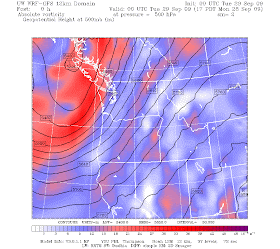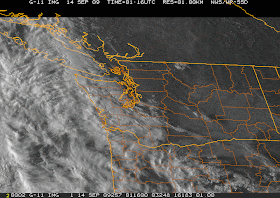
Picture courtesy of
KOMO TV
means "place of evil spirits" in the native American vernacular and it lived up to its name on Sunday: a tornado, which started around
Bonney Lake moved eastward until weakening over the the town. According to an excellent report by the National Weather Service this was a confirmed category 1 storm with winds reaching 100-110 mph. The funnel hit the ground around 4:15 PM on Sunday and continued for 9.6 miles and 16 minutes. A barn and silo was lost, some greenhouses damaged, and lots of tree damage.
The news outlets have been hitting this real hard (for once they didn't have to hype the storm...this was the real thing!).
Tornadoes are rare around here, because they generally form from
supercell storms and squall lines...intense thunderstorm features that we infrequently get around here. Why don't we get powerful thunderstorms? The cool waters of the Pacific are to blame. Cool water means a lack of moisture in the air (since warm air contains more moisture than cool air), and cool air near the surface generally works against developing a large change in temperature with height...which convection needs to form (or you require in your saucepan to get convection of your hot cereal).
On Sunday the air was quite unstable for around here, with relatively mild temps near the surface and cold air moving in aloft. And the convection was initiated by an upper level feature moving in aloft. And your remember the resulting lines of convection--with some embedded thunderstorms--that pounded the whole area that day. One of those thunderstorms produced that tornado. In my book I talk in depth about how these non-
supercell tornadoes form, so I won't go into too much detail here. But they generally form near some kind of shear line at low levels, where wind changes direction substantially with distance.


Anyway, the first thing I did was to look at the visible satellite picture and weather radar to see if I could spot the storm...and I have attached what I found. Hard to see the storm on the visible image unless your really knew what you were looking for, but in the radar you can see it clearly...that area of green and yellow southeast of Tacoma. Can you spot it? A problem is that Enumclaw is a good distance from the radar (which is on Camano Island).
Next I looked at the Doppler velocity of the radar, which you never see on TV. Ironically, they NEVER show the Doppler part of the Doppler radars! (Funny story...when KING-5 got their own Doppler radar, they showed the velocities for a few days...that didn't last long. It is really hard to interpret Doppler images).
Below is an example of the Doppler velocities with the overall wind removed (storm-relative velocity). You can sometimes see rotation by a sharp reveral of color in a small area (the signature of the mesocyclone associated with the tornado). There is a hint of a feature (the small yellow dot with the green next to it in around the right place) that was there for several scans...but it hard to know whether that really signified anything. Looking at this image you can see why they don't show Doppler radar images on TV!






































